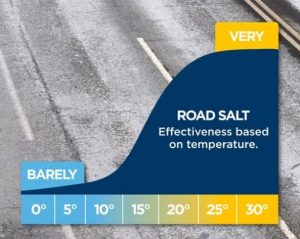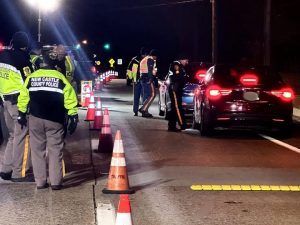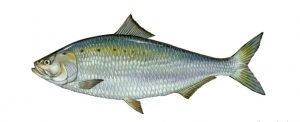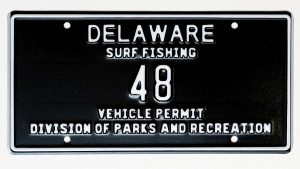
Increased Attentive Driving Encouraged with Shorter Days and Increased Deer Activity around Dusk and Dawn
With clocks falling back to Eastern Standard Time in early November and with days already growing shorter, it’s a dangerous time of year on the roadways because of increasing activity of white-tailed deer due to their annual mating season. Known as the rut, the season lasts from mid to late October through November and on into December, with males (bucks) fully focused on pursuing females (does) in the First State. This year, the Delaware Department of Natural Resources and Environmental Control, the Delaware Office of Highway Safety (OHS) within the Department of Safety and Homeland Security and Delaware State Police (DSP) are again urging extra caution at the wheel, especially after the Nov. 3 change from Daylight Saving Time to EST.
“Spurred by the rut, bucks chasing does will repeatedly cross Delaware roadways without any instincts telling them not to go there, and creating a hazard for motorists,” said DNREC Division of Fish and Wildlife biologist Sam Millman, adding that soon bucks will start expanding their home travel ranges as the rut approaches. “That’s why we remind Delaware drivers to take extra precautions this time of year, especially when traveling on dark backroads and roadways lined by woodlands and forests, where white-tailed deer are more likely to cross.”
From now through the holiday season, the busiest times for motorists on Delaware roadways are around dusk and dawn – and these times coincide with the times deer also are typically most active. Driving on unlit rural roads without heavy traffic or traveling busier roadways bordered by woods are the most common scenarios for deer-vehicle collisions in Delaware.
The latest figures from OHS also show that most deer-vehicle collisions in Delaware occur between 5 a.m. and 7 a.m., spiking again between 5 p.m. and midnight. In 2023, the state recorded 1,616 crashes involving deer on the roadway. To date in 2024, there have been more than 839 deer-related crashes. OHS data also finds deer-related crashes to be most common in October, November and December, representing 47% of all Delaware vehicle-deer collisions from 2019 to 2023.
“Slowing down and avoiding distractions can decrease your chances of a collision. Always be attentive behind the wheel and be prepared for unexpected situations such as deer darting out into the roadway,” said Sharon Bryson, director of the Delaware Office of Highway Safety. “Using high beams in dark and low-light areas can help make it easier to see deer that could be near the road. We want to remind drivers to take extra precautions during the fall and winter seasons to ensure everyone can arrive alive.”
Although the average white-tailed deer in Delaware weighs about 140 pounds, larger bucks can tip the scales at 200 pounds or more, according to the DNREC Division of Fish and Wildlife. Besides doing costly damage to vehicles involved in a collision, hitting an animal that size can also result in injury to drivers or passengers – or trigger an accident involving other motorists.
In 2023, 1,758, or 95% of the 1,857 animal-related collisions investigated by the Delaware State Police involved deer. Of that number, 864 collisions occurred during the deer mating season.
“As we enter deer mating season, it’s crucial for drivers to stay alert,” said Lieutenant India Sturgis, DSP director of public information. “In Delaware, nearly 50% of our animal-related crashes in 2023 involved deer during this period. Deer are more active and can appear suddenly, especially at dawn and dusk. To minimize the risk of crashes, remember these tips: stay vigilant, reduce your speed, use your high beams when it’s safe to do so, and be on the lookout for deer crossing the road. While these precautions can’t guarantee you’ll avoid a collision, they can significantly enhance your safety and reduce potential damage to your vehicle.”
Based on reported insurance claims from July 1, 2023 to June 20, 2024, State Farm Insurance ranks Delaware 30th nationally, with drivers having an increased chance to 1-in-135 of being involved in an animal collision, and with deer accounting for the great majority of animal-related crashes and vehicle damage claims. Also, during the same timeframe Delaware drivers now rank 43rd in the nation, for the number of estimated animal collision claims filed, with nearly 6,400 claims, up by nearly 400. By comparison, from July 1, 2022 to June 20, 2023, State Farm ranked Delaware 33rd nationally, with drivers having a 1-in-148 chance of being involved in animal collision and nearly 6,000 estimated animal collision claims filed.
To avoid a large out-of-pocket expense, AAA Mid-Atlantic which provides coverage for Delaware motorists, recommends purchasing a policy that includes comprehensive coverage for collisions with deer or other animals. AAA Mid-Atlantic also notes the average claim submitted for a deer strike in Delaware was more than $7,000 in 2023, up almost 35% compared to 2022. While the vast majority of deer strikes do not involve serious injury, according to the Insurance Institute for Highway Safety (IIHS), in the 10-year period from 2013-2022, almost 1,900 people nationwide were killed in crashes involving animals, including three in Delaware.
“Safety is priority one, so first and foremost, AAA encourages motorists to adjust their driving behaviors to prevent a deer collision, said Jana Tidwell, spokesperson for AAA Mid-Atlantic. “Repairs for crashes involving animals are covered by comprehensive insurance, so drivers should talk to their insurer to understand and, if necessary, adjust their coverage as even minor collisions will likely lead to a major expense.”
DNREC, OHS and DSP, along with all police agencies and auto insurance companies, are unanimous in naming attentive driving as the best way to prevent or lessen the severity of deer-vehicle collisions. Attentive driving entails avoiding distractions that can take a driver’s eyes off the road, such as mobile phones, adjusting the radio or in-car computer screen, eating while driving, and engaging a driver in passenger activities. Results from a State Farm survey indicate that just one risky driving behavior, such as speeding or using your phone, increases the chance of an animal collision by 23%.
Additional safety tips from the three Delaware agencies promoting safe driving not only apply during the rut but any time deer might be active 365 days a year, including:
- Always wear your seatbelt to reduce your risk of injury in a collision.
- Reduce speed at night, on curves and in bad weather.
- Switch to high beams when there is no oncoming traffic to better reflect the eyes of deer on or near the roadway and scan the sides of the road as well as what’s directly ahead.
- Watch for “Deer Crossing” signs marking commonly-traveled areas by deer on the road ahead. Slow down immediately and proceed with caution until past the crossing point.
- Be aware deer usually travel in groups, so if you see one deer, there are likely to be others.
- When deer are sighted, slow down and blow your horn with one long blast to frighten them away. Do not depend on devices such as deer whistles, deer fences and reflectors to deter deer, as these devices have not been proven to reduce deer-vehicle collisions.
- Do not swerve to miss a deer – brake and stay in your lane. Losing control of your vehicle, crossing into another lane, hitting an oncoming vehicle, or leaving the roadway and striking a tree or utility pole will likely result in a much more serious outcome than hitting a deer.
- If you hit a deer, and your vehicle is damaged, stop at the scene, get your car off the road, if possible, turn on your vehicle hazard lights – and if you or anyone in your vehicle are injured, call 911.
- Do not touch the animal or get too close to it. An injured deer may bite or kick and are capable of causing serious injury.
About DNREC
The Delaware Department of Natural Resources and Environmental Control protects and manages the state’s natural resources, protects public health, provides outdoor recreational opportunities and educates Delawareans about the environment. The DNREC Division of Fish and Wildlife, within which the Mosquito Control Section operates, conserves and manages Delaware’s fish and wildlife and their habitats, and provides fishing, hunting, wildlife viewing and boating access on more than 68,000 acres of public land owned or managed by the Division of Fish and Wildlife. For more information, visit the website and connect with @DelawareDNREC on Facebook, Instagram, X (formerly known as Twitter) or LinkedIn.
Media Contacts: Michael Globetti, michael.globetti@delaware.gov; Joanna Wilson, joanna.wilson@delaware.gov


















































































